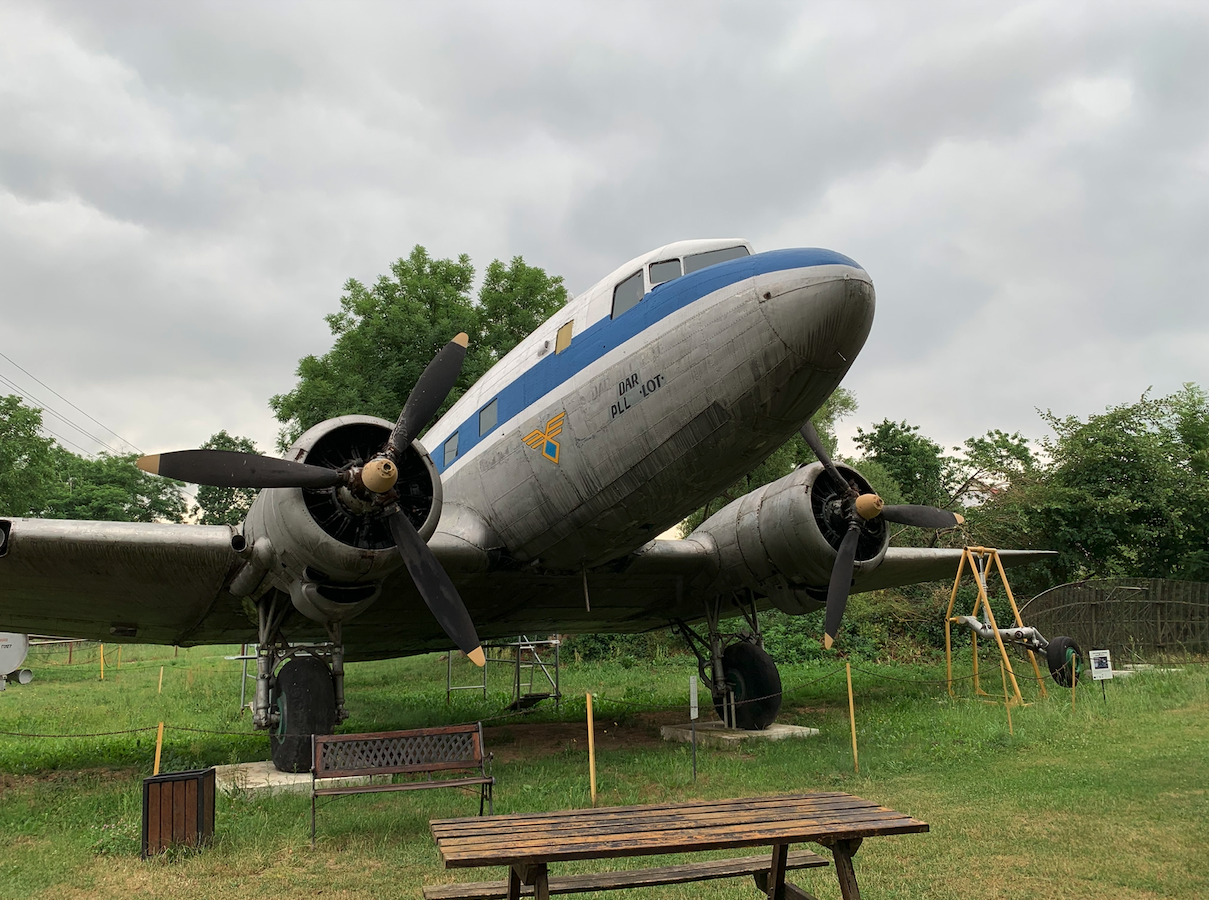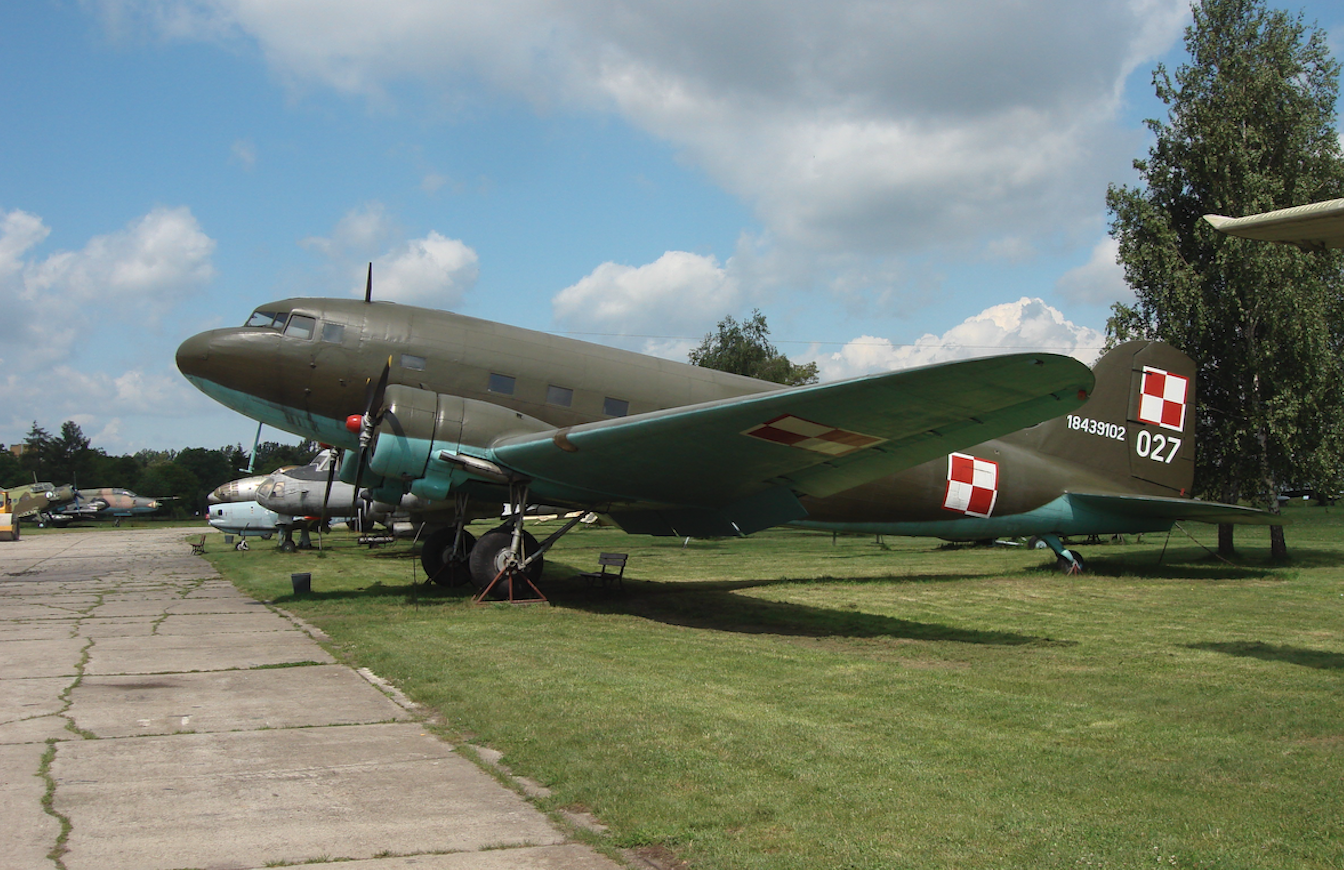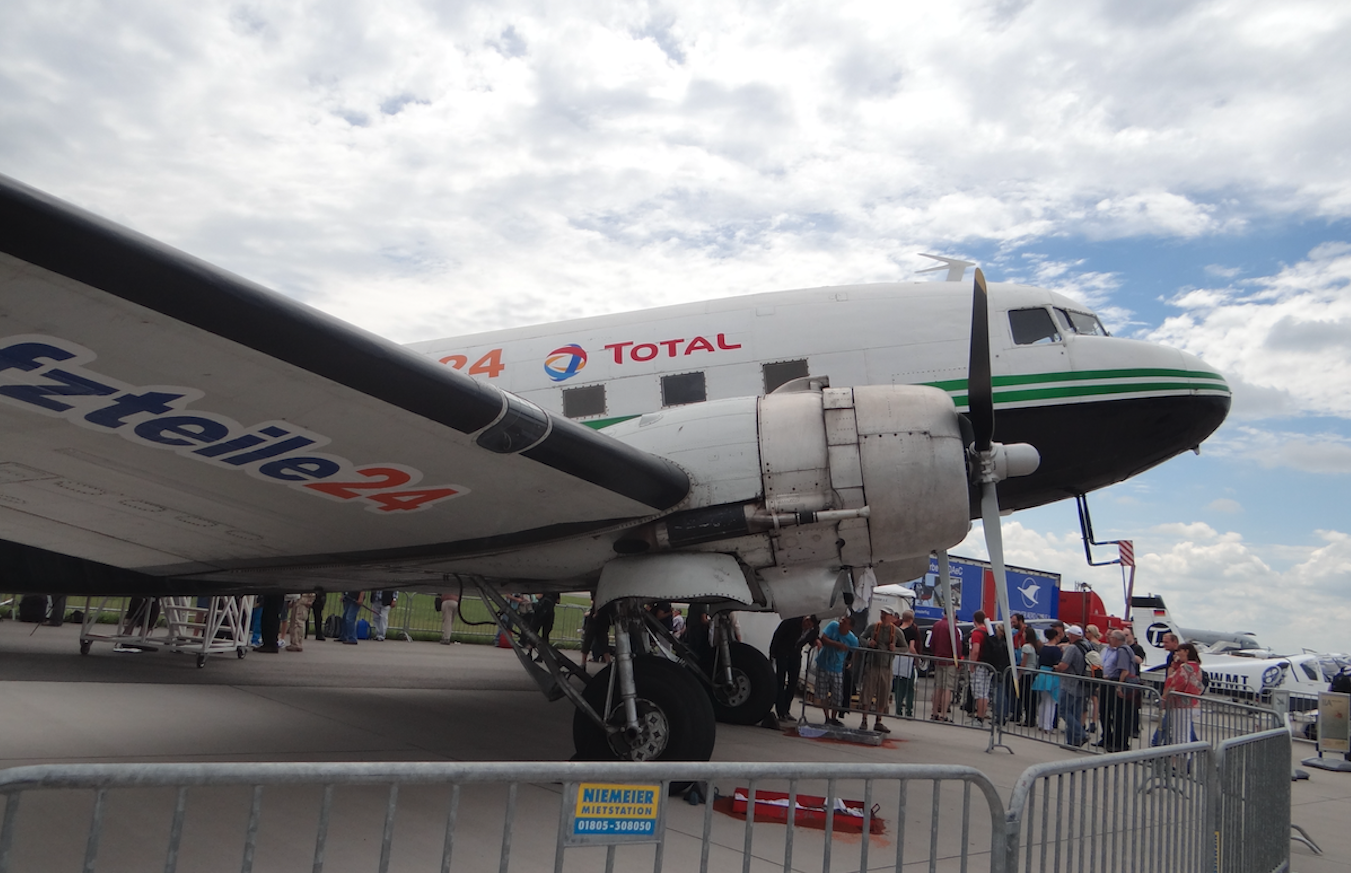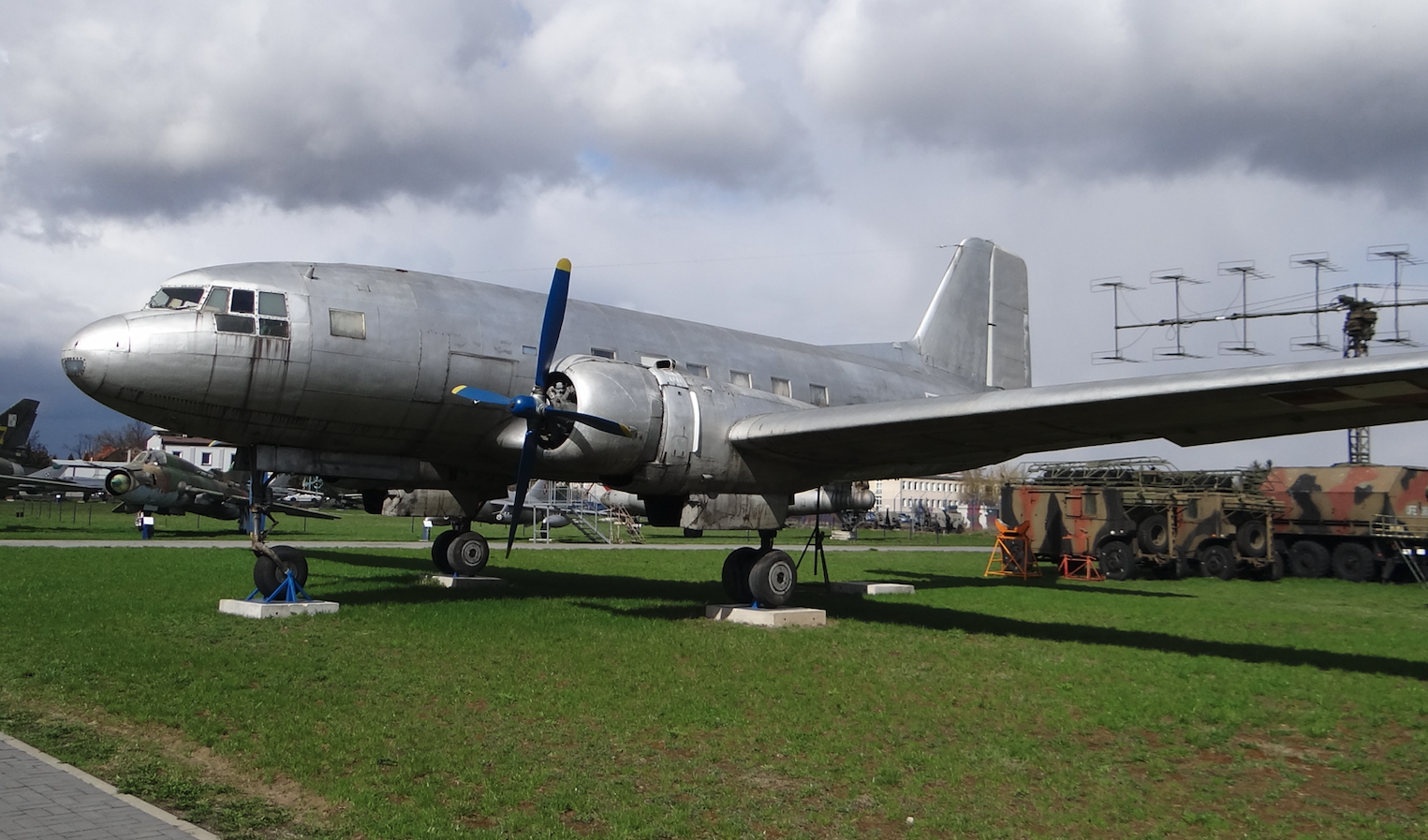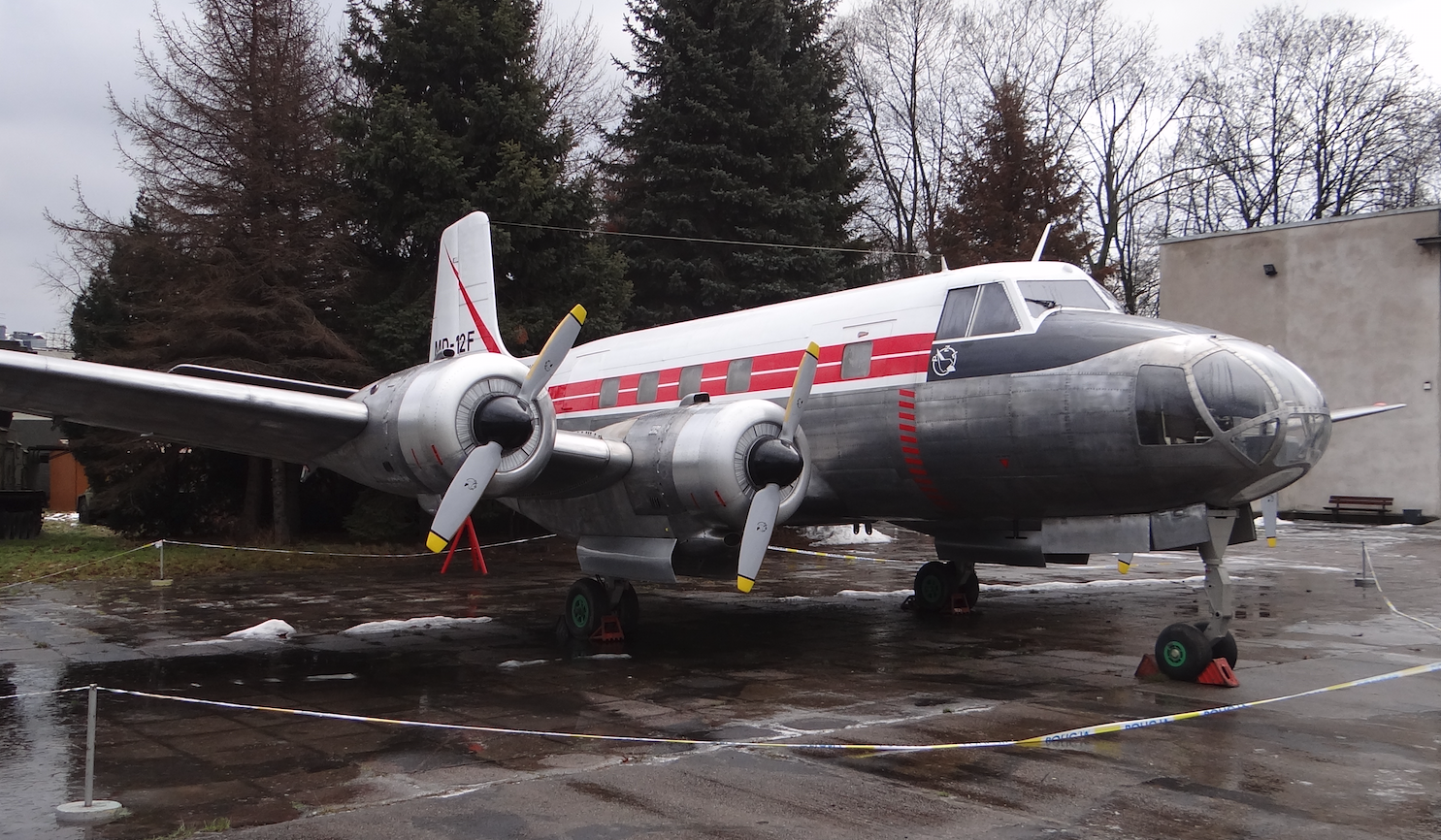Kraków 2014-04-15
The history of LOT Polish Airlines.
Part 2.
1945-1962.
After the Second World War.
In 1944, a new occupation of Poland began. This time Moscow. The power in Poland was exercised by the Kremlin with the help of the communist government in Poland that it established. In order to maintain the appearance of democracy, pre-war institutions were revived, but with a new, communist leadership. In March 1945, the PLL LOT company was reactivated. Only the Crane, the company’s logo, has remained from the pre-war company. Even the state-self-government management system has not been preserved. The company’s management became military-communist.
But the beginnings of the post-war LOT Polish Airlines can be found in the Civil Aviation Department, which was organized in 1944. On August 15, 1944, the Civil Aviation Department launched two airlines; Lublin (Dys Airport) – Białystok and a circular line Lublin – Przemyśl – Rzeszów – Lublin. The Dys airport was located 10 km north of Lublin. Soon, a connection to Mińsk Mazowiecki was launched, which was replaced with Warsaw after January 17, 1945. Flights to Lviv and Vilnius were considered, but Moscow banned them because these cities were incorporated into the CCCP. The flights were carried out for the Polish Committee of National Liberation (attached to the Kremlin) with the help of three Li-2 planes, and later also with small Po-2 planes. The passengers were functionaries of the new government. Service mail and propaganda materials were delivered. By the end of 1944, almost 5,000 people and 70,000 kg of parcels were transported.
On March 6, 1945, LOT Polish Airlines was reactivated at the Civil Aviation Department. on March 16, 1945, a decision was made that the Air Force Command would take care of the organization of LOT Polish Airlines. Therefore, on March 28, 1945, the Order of the Polish Army Commander No. 66 / org. About the creation of four civilian aviation units. The order mentioned, inter alia, the creation; 7. Independent Civil Aviation Transport Squadron, which had 10 Li-2 aircraft. On the other hand, the 18th and 19th Independent Civil Aviation Regiment had over 100 Po-2 planes and carried mail and newspapers. From the Order mentioned above, another unit arose; 8. Independent Transport Squadron, which performed flights commissioned by the Ministry of Public Security. It transported, among others, arrested and convicted members of the reactionary underground, i.e. the Steadfast Soldiers.
On March 30, 1945, the 7th Independent Civil Aviation Transport Squadron, which was in fact a company of PLL LOT, launched the first circular line; Warsaw-Łódź-Krakow-Rzeszów-Lublin-Warsaw. In the first three months, around 1,500 flights were made and around 20,000 people were transported. In March, April and May 1945, national branches of PLL LOT were established in several cities. These were branches in Łódź, Kraków, Rzeszów, Lublin, Białystok, Katowice, Wrocław, Poznań, Bydgoszcz, Koszalin and Gdańsk.
The first post-war advertising poster of LOT Polish Airlines showed planes flying over the ruins next to a key of cranes. The inscription on the poster reads: "LOT Polish Airlines wings will help in rebuilding".
On July 18, 1945, by a decree of the Council of Ministers, the LOT Polish Airlines State Enterprise was established, transformed from the 7th SETLC. Wojciech Zieliński, a pre-war proxy of PLL LOT, became the general director.
In July and August 1945, all aircraft received Polish registrations. Polish pilots also arrived, because until now the crews were composed of Russian soldiers. The first Polish pilots were; Medard Konieczny, Stanisław Kostecki, Mieczysław Sadowski, Zdzisław Stróżowski, Władysław Szumowski, Stanisław Żyźniewski. Then another Polish group of aviators, navigators, radio operators and on-board mechanics was trained. In September 1945, a second pilot course was held. By the end of 1945, over 100 people had been trained (trained); 25 pilots, 8 navigators, 23 radio operators and 25 flight engineers.
As the communists increased their demand for the topic of "perpetuating the people’s power" and the demand for flights, the number of flights for commercial transport decreased drastically. From September to December 1945, not even 150 flights were made. Although the offer already included a circular route; Warsaw – Łódź – Katowice – Poznań – Łódź – Warsaw and flights to Bydgoszcz and Gdańsk.
On December 6, 1945, the Order to dismantle four civil aviation transport units was published. The Li-2 planes were given the colors of PLL LOT, and the Po-2 planes were sent to the Department of Civil Aviation.
1946 year.
In 1946, 10 Lisunow Li-2 planes were actually taken over from the Polish Army. At the same time, the first regular connection Warsaw (Okęcie Airport) – Gdańsk (Wrzeszcz Airport) was launched. On August 8, 1946, the Council of Ministers approved the statute of PLL LOT and actually 1946 should be considered as the reactivation of PLL LOT.
Lisunow Li-2 planes were operated by LOT Polish Airlines until 1967, and they were removed from the state in 1969. Certainly, the Li-2 aircraft was the most frequently operated aircraft in LOT Polish Airlines. In 1955, there were 40 of them.
Also in 1946, 9 DC-3 machines were purchased for PLL LOT, which began to be operated on foreign lines. They received registrations: SP-LKA, SP-LKB, SP-LKC, SP-LKD, SP-LKE, SP-LKF, SP-LKG, SP-LKH, SP-LKI. These were surplus planes, C-47 A version. There were only metal benches in the passenger cabin. A lot of these planes were built during the Second World War, and after the war they were very cheap. The cabin was modernized and 21 seats were installed, in a 2 + 1 arrangement in 7 rows. In 1957, another interior modification was made with 24 seats. These planes made flights abroad to: Paris, Stockholm, Prague and Berlin. The last DC-3 in LOT Polish Airlines ended its service in 1959 and was sold to Iran.
1947 year.
On March 21, 1947, a four-engine SNCASE SE-161 Languedoc passenger plane was demonstrated in Warsaw. In May 1947, LOT Polish Airlines purchased 5 aircraft of this type. They were intended primarily for servicing longer foreign lines. The purchased SE-161/1 Languedoc B-2 aircraft were manufactured in the period 1946 – 1947. They received registration marks: SP-LDA, SP-LDB, SP-LDC, SP-LDD, SP-LDE. The first three machines arrived in Poland on July 5, 1947, and from August 1, 1947, they entered the route. In October 1947, the fourth aircraft arrived, and the fifth in 1948.
Initially, it was planned to purchase a total of 10 SE-161 aircraft to ensure the rapid development of foreign airlines. Unfortunately, the engines turned out to be very emergency. They led to several forced landings. On May 31, 1948, during the flight of the SP-LDA plane from Warsaw to Paris, 3 engines stopped in succession and the plane forcibly landed with the folded landing gear near Reims. Fortunately, the passengers were fine and the plane needed to be repaired. After this accident, all SE-161 aircraft at LOT Polish Airlines were suspended. The factory offered to replace the engines with the Pratt Whitney R-1830. The engines, however, were not replaced, and in the spring of 1950, the planes were canceled. Together with the renovated SP-LDA, not collected from France. Languedoc was the first 4-engine aircraft used in Polish air transport. The terrible technical condition of the SNCASE SE-161 Languedoc planes gave the communists an excellent argument about the poor quality of Western technology. Human tragedies are also associated with the use of Languedoc by LOT Polish Airlines. The authorities of the Polish People’s Republic accused several key PLL LOT employees related to the operation of this aircraft with sabotage activities and sentenced them to death.
1949 year.
In 1949, LOT Polish Airlines purchased 5 Ił-12 B passenger aircraft, which received registration marks: SP-LHA, SP-LHB, SP-LHC, SP-LHD, SP-LHE. The new aircraft was first demonstrated to the public at Okęcie on September 4, 1949, on the occasion of the Aviation Day. The plane was also shown in the air, demonstrating a flight with a climb with one engine running with the other engine turned off, the blades of which were set in a pennant. The planes had 18 or 21 passenger seats. During operation, their number was increased to 28.
In 1952, another Il-12 B plane was rented for a few months, and it was registered with the SP-LHF. At LOT Polish Airlines, the planes were used until the end of 1957, and the last three machines, with registrations SP-LHA, SP-LHB, and SP-LHC, were kept in reserve until November 1959. Iliuszyn Ił-12 planes allowed to increase the network of connections. Flights to Bucharest, Budapest, Brussels and Copenhagen have started.
1955 year.
The PLL LOT company bought from CCCP in 1955, 4 Iliuszyn Ił-14 P planes, and in 1956, another two. In 1957, 6 VEB Il-14 P machines were imported from the GDR and one passenger-transport AV-14 with large loading doors from Czechoslovakia. Aircraft with CCCP received the designations SP-LNA, SP-LNB, SP-LNC, SP-LND, SP-LNE, SP-LAF. Airplanes from the GDR were marked with the registrations SP-LNG, SP-LNH, SP-LNJ, SP-LNK, SP-LNL, SP-LNM. The aircraft from Czechoslovakia AV-14 received registration SP-LNN. In addition, in the period 1963-1964, the company PLL LOT rented 3 VEB Ił-14 P planes. They had different serial numbers, but received the registration SP-LNO, SP-LNP, SP-LNR. In total, LOT Polish Airlines operated 16 Il-14 machines.
During operation in PLL LOT, the planes underwent numerous modernizations. The number of passenger seats was increased from 18 to 26, and then 32. The dorsal astro domes in the Il-14 P were removed. VEB Il-14 P airplanes did not have them at all. The wing was strengthened and an eighth window in the front of the passenger compartment was added, along with other minor changes.
In 1955, new air connections were launched to; Vienna and Moscow. Perhaps some readers are surprised by the launch of a connection to Moscow only in 1955. But you need to know that the permanent connection between Warsaw and Moscow was maintained by military planes operating from the Bemowo Airport.
According to the available information, it was in 1955 that LOT Polish Airlines recorded the first 1,000,000 passengers carried since its inception.
Convair Liner CV-240 at LOT Polish Airlines. 1957 year.
As Western European countries did not want to accept CCCP aircraft, the Polish carrier PLL LOT was forced to purchase aircraft from behind the Iron Curtain. It was the period of the People’s Republic of Poland after the Poznań Uprising and there were few symptoms of the thaw. In the fall of 1957, the first three Convair Liner CV-240-12 planes were purchased from Sabena. The planes were equipped with Pratt-Whitney R-2800-CB16 engines. They received registrations; SP-LPA, SP-LPB, SP-LPC. Sabena (Societe Anonyme Belge d’Exploitation de la Navigation Aerienne) was the state-owned airline in Belgium. Established in 1923 and collapsed in 2001. Headquarters Brussels. The planes landed at Okęcie Airport on October 15, 1957. From April 1, 1958, the planes entered the network of PLL LOT connections. The planes were used on the Warsaw-Vienna, Warsaw-Paris, Warsaw-London and Warsaw-Zurich lines. The latter two connections were new to the grid and were launched in 1958. Convair CV-240 planes were the first machines in LOT Polish Airlines with a hermetic cabin and at the same time the largest in the fleet.
During the training of the crews on April 12, 1958, a Convair CV-240 accident occurred at Okęcie Airport, registration SP-LPB. During take-off, during the climb, the plane lost its way and hit the ground. It was severely damaged and a decision was made to delete it. The official announcement spoke of a crew pilot error. It’s easy to blame it on the crew. How typical and simple.
As the planes performed very well and were economical, at the beginning of 1959, a decision was made to buy another two used machines. Found on the secondary market; (KLM line) Convair CV-240-2, which received SP-LPD registrations, and (Iran Air line) Convair CV-240-4, which received SP-LPE registrations. Both planes had Pratt & Whitney R-2800-CA18 engines. Four aircraft (SP-LPA, SP-LPC, SP-LPD and SP-LPE) were intensively used until 1964. In 1965, difficulties arose. Officially, there were talk of problems with obtaining spare parts. In fact, the communists wanted to get rid of imperialist planes. In 1965, Poland received the last new Il-18 aircraft, produced by CCCP. In total, there were already 10 Ił-18 machines in Poland, used in the Polish Army and LOT Polish Airlines. Ultimately, the Ił-18 aircraft operated in Poland took 105 passengers on board. These planes fully covered the demand for the operation of the PLL LOT connection network. Therefore, in 1966, four Convair CV-240s and the last Vickers Viscount (SP-LVC registration) were put up for sale. Convair CV-240 aircraft returned to the USA.
1961 year.
On August 24, 1961, PLL LOT and WSK-Okęcie concluded an agreement providing for the lease by PLL LOT of the MD-12 aircraft for the carriage of passengers on the Warsaw-Rzeszów-Warsaw route in the period from August 28, 1961 to September 30, 1961. The MD-12 machine is a Polish passenger plane developed at PZL-Okęcie. The purpose of the contract was; assessment of the suitability of MD-12 at LOT. Assess cruising speed with passengers and fuel consumption. Collected experiences for future operation at LOT.
120 flights were made and a total of 1,730 people were transported in the total flight time of 129 hours. Flights were made back and forth twice a day. It is not difficult to calculate from this that; One trip lasted about 1 hour. The average speed was 280 km / h. The total cost of propellants per 1 hour of flight was 55.4% of the cost for Li-2. The total cost of fuel for 1 hour and 1 passenger was 58.5% of the cost for Li-2. Total fuel cost per passenger-kilometer was 57.0% of the cost for Li-2. Due to the maximum range of the plane, which was 650 km, the plane could be refueled only at Okęcie. As a result, the ability of the MD-12 aircraft to operate economically was confirmed in practice. The plane fulfills the tasks set before it. In the period 1962 – 1963, a series of advertising, excursion and business flights continued. However, this did not affect the interest in the plane by LOT Polish Airlines. It did not, because it could not, in such a configuration of power. It’s just that the star pattern for MD-12 was unfavorable, right from the start. Work continued at the plant, mainly to improve heating and de-icing. Over reducing noise. On improving the range of radio devices.
Iliuszyn Ił-18 in LOT Polish Airlines.
Since 1959, Moscow has offered the first turboprop passenger plane Il-18, the progenitor of which is the B-29 bomber. In March 1961, the first three Il-18 W aircraft were delivered to Poland. They received registration marks SP-LSA No. 180002403, SP-LSB No. 180002404, SP-LSC No. 181002805. These were new aircraft. The first two from 1960, the third from 1961.
In April 1964, another Il-18 W, no. 184007102, registered as SP-LSD, arrived. It was also a new plane built in 1964. At the end of 1965. LOT Polish Airlines purchased more machines; Il-18 W SP-LSE No. 181002504, used and built in 1961. The next ones are two new Il-18 E, manufactured in 1965. SP-LSF No. 185008601 and SP-LSG No. 185008603. In July 1966, the eighth Il-18 W SP-LSH No. 181002701 arrived in Warsaw. The aircraft was used and has already undergone the first renovation. It was built in 1961. The ninth Il-18 version E was taken over by LOT Polish Airlines from the army in March 1975. SP-LSI No. 185008905 was built in 1965.
Airplanes in PLL LOT started servicing foreign connections. The first flight was made by the Il-18 SP-LSA on May 24, 1961, to Moscow. Most of the aircraft were made with a single class, lux, 87-seat cabin. During the renovation, they were completely converted into economy class with 99 seats. Repairs were carried out in plants in Moscow at Bykovo airport. During the repairs, the avionics equipment was modernized to meet the new requirements. New antennas appeared on the hulls. Instrument panels in the cockpit were also changed. Recent modifications of the Polish Ił-18 have led to their unification to 105 passenger seats. The differences between the individual copies have completely disappeared. In June 1975, two Il-18 planes; SP-LSA and SP-LSC were converted into goods. The armchairs were removed from them. Larger side cargo doors have been installed. The Ił-18 aircraft in LOT Polish Airlines departed annually on average 1,600 – 1,800 hours. No catastrophe happened at the Polskie Ił-18. At the turn of the 1980s and 1990s, the Il-18 planes were withdrawn from LOT Polish Airlines. Several machines were taken over by the Polonia Airways company and these planes were still flying in 1997. In 2004, five more former Polish Il-18s (SP-LSF, SP-LSG, SP-LSI, SP-LSK, SP-FNW) were in operation. The plane had several advantages. As for those times, it had a large capacity, long range, high reliability, high lifting capacity, spacious passenger compartment, relatively wide comfortable seats, wide passage between the seats. The disadvantages include; high noise level in the cabin, considerable vibrations characteristic of the engines used.
Vickers Viscount for PLL LOT. 1962 year.
All the reasons why the communists decided to buy Vickers Viscount (1962) planes are unknown, and it was in the period when the only correct technique from CCCP reigned in the People’s Republic of Poland. It should be assumed that the reason was the problems with accepting Russian planes at Western airports. Russian planes did not meet the standards of the West. At that time, the Polish carrier PLL LOT had the following machines: Ił-2 / DC-3, Ił-12, Ił-14. The Il-18 was put into operation. The WSK Okęcie OKL MD-12 program has been deleted. In the period 1957 – 1966, LOT Polish Airlines also had four Convair CV-240 planes. These were second-hand purchased machines. It was these machines that served the routes in Western Europe, mainly to London. In 1961, LOT Polish Airlines enriched itself with three new Il-18 turboprops, but they were not allowed to land in Western European ports (at least initially), and Western travelers did not want to board them.
In March 1962, LOT Polish Airlines signed agreements to launch new cruise connections to Rome, Amsterdam and Cairo. There was a rumor that it was a shame to send the Convair CV-240 (?) On the new routes, so a new plane was needed. Initially, it was planned to purchase new machines (after all, Vickers Viscount was still being produced). However, the communists decided to buy three Vickers Viscount Type 804 machines, from the British company BUA (British United Airlines). The planes were about 5 years old. They flew on the inner lines of the British Isles. They had 56 passenger seats. Their cruising speed was twice that of the Il-12 / Il-14 aircraft. There was a rumor that the deal was a special occasion. But, the occasion was BUA’s approval to sell these machines to a communist country. The fact is that the price of the planes included the replacement of passenger seat upholstery with a new one, in the LOT colors.
Importantly, the planes had radar stations. But the communists were reluctant to pay for this equipment, considering it an excess, so the machines were delivered devoid of this equipment. As it turned out, this had far-reaching consequences. There is, however, a second possibility; that BUA did not obtain permission to sell machines with radar stations, as these could be used for military purposes. In the third possibility it is said; that the radar stations were already obsolete and the planes had to be fitted with new ones, those that were installed in the newly produced copies. These stations were manufactured by the US and would require approval from the US administration, which would allegedly be lengthy, costly and would require additional crew training. There is also information that the money was allocated to the purchase of radar stations, but was allocated to the purchase of start-up compressors to equip several airports in Poland. How it really was, we will probably never find out.
In September 1962, a group of 15 Polish airmen left for the UK. Almost all of them had air travel of over 1,000,000 km. There were also those who conquered the first million kilometers even before the attack of the German army on the Republic of Poland. The whole group successfully passed the theory. The flights turned out to be a novelty, because the English were already using the ILS system as standard. In 1960, the ILS system was purchased for Okęcie Airport, but it was not installed until the end of 1962. (Apparently there was no cable that you had to buy in the West for foreign currency!). The English were amazed how Polish pilots land smoothly using the NDB system, which was archaic there. And in Poland it was used for the next 50 years (!). After eight weeks (November 1962), the management of PLL LOT arbitrarily stated that "Polish crews are well trained and can return to the country." However, the English said the training was not completed and they did not issue a license. However, they could not stop the handover of the planes. The English also offered to delegate instructors to Poland. Also, the management of PLL LOT did not agree to such a solution. The whole thing had a second bottom. The management of PLL LOT was afraid that the pilots would like it in the West so much that they would not want to return to the country. To improve the psychological comfort of the airmen, LOT management decided that the crews will temporarily be three people, although the plane was piloted by a two-person crew as a standard.
Airplanes were assigned registration marks; SP-LVA, SP-LVB and SP-LVC. The first plane landed in Warsaw on November 6, 1962 and received SP-LVA registration. The second one landed on November 27, 1962 (SP-LVB). The third was delivered on December 22, 1962 (SP-LVC). When on November 6, 1962 (Tuesday) Vickers Viscount SP-LVA landed at Okęcie Airport and was greeted by party authorities and residents of the capital. Extensive articles on this subject appeared in the newspapers. The airplanes were described very flatteringly. The next day (November 7, 1962) a propaganda flight took place.
By the time the last aircraft was delivered, the Vickers Viscount Type 804 SP-LVB was headed to Brussels. The return took place on December 19, 1962. Brussels-Warsaw cruise, stopping over in Berlin. There were 28 passengers and 5 crew members on board. Total 33 people. The crew of Captain – Mieczysław Rzepecki, at that time one of the youngest pilots in LOT Polish Airlines, but he had already flown 2,500,000 km in the air, co-pilot – Henryk Kafarski, instructor-controller – Józef Marczyk and two flight attendants – Maria Kowalik and Halina Breitkoph-Kieszkowska. The whole flight was smooth. At 17:55, the plane took off from Berlin as planned. However, the weather conditions over Warsaw were very bad. The overall visibility was around 1,000 m (according to other data 7,000 m), the cloud base was only 80 meters (according to other data 250 m). The plane was about to land on RWY 33. The crew used the signals of two (according to other data, three) NDB beacons and the ADF radiocompass. At around 19:20 the crew was cleared to land. The first approach was unsuccessful (the plane was flying too high) and the crew directed the machine to the second circle. It is uncertain whether the crew saw the RWY lights on the first attempt. After the 4th turn, while already on the straight, the plane unexpectedly lost altitude. It fell from a height of 60-70 m. It hit the ground with force, then bouncing off the frozen ground. He turned sharply left. Wings and a piece of tail had fallen off the fuselage. While gliding along the ground at high speed, it burst into flames. After stopping, the fuel tanks exploded. After a while, the Fire Department and Ambulance Service arrived at the scene. Nobody survived the crash. Honor their memory! It was 19:31. It was 1,335 m up to the RWY 33 threshold. The plane in LOT Polish Airlines took only 84 hours. Among the victims was, among others, Polish engineer Fryderyk Bluemke, constructor of two-stroke engines, incl. S-31 engine for the Syrena car and Marcin Szeligiewicz, Polish educator and cultural activist, composer and pianist.
The main Commission for Aircraft Accident Investigation of the Ministry of Communications, who conducted the investigation, stated that at the time of the crash, the plane was already configured for landing: with its wing flaps extended and the landing gear extended. It was also found that there was no explosion in the air, and all damage occurred at the moment of the collision with the ground. The plane landed in difficult weather conditions; in winter, after dusk, during ground fog, with 6/8 cloudiness, with a ceiling of fractostratus clouds of 250 m, visibility at 7,000 m and a temperature of -5 degrees. However, other sources spoke of even more difficult weather conditions. (visibility 1 000 m, cloud base 80 m and haze). If so, the controller should send the plane back to another airport (Modlin or Łęczyca). There is also a presumption that one of the NDB beacons has failed. The exact cause of the crash is unknown. One of the possible causes is a stretching. The design of the Rolls-Royce turboprop engines was designed to protect against sudden changes in rotational speed. At a relatively low rotational speed, when the pilot was suddenly adding throttle, the propeller blades reduced the angle of attack for a few seconds to facilitate the acceleration of the propeller. Then they set up for more work and only then the plane accelerated. The airplane manual clearly forbade abrupt changes to the gas throttle, which was normal practice in reciprocating airplanes. The fact is that all the blame for the catastrophe was placed on the captain, who could not defend himself. The official report did not mention; unfinished training in England, broken NDB beacons, unmounted ILS system. How characteristic it is for Commies and Masons. The aftermath of the tragedy was to bring an English instructor and install the ILS system.
On August 20, 1965, the Vickers Viscount, registration SP-LVA, took off from Okęcie Airport. Only the crew were on board. The plane landed at the Ławica Airport in Poznań. From there, he picked up passengers (mostly children and teenagers) and flew to Lille, France. Then to Brussels, Belgium. At the very end, Viscount was to return to Wrocław without any passengers. The crew of the SP-LVA were: Captain – Leszek Kmin, co-pilot – Marian Kowalewicz and two flight attendants – Emilia Martowska and Jadwiga Kowalczuk. On that day, storm fronts passed through all of Europe. The problems started on the way back from Belgium to Poland. Belgium’s area inspectors saw the plane on the radar screens but no communication with the crew. Numerous violent maneuvers of the plane were observed. Perhaps the crew was trying to avoid local storms. The wreckage of the machine was found near Jeuk St. Troud in France. Viscount crashed, previously hitting electricity pylons. All crew died. Honor their memory! The cause of this disaster has not been clarified. There are different versions of the events, unfortunately no evidence is available. The plane was probably struck by lightning, which could damage the electrical system and cause orientation problems.
LOT Polish Airlines decided to get rid of the last Viscount, which made the last scheduled flight in 1966. In 1969, PLL LOT put SP-LVC up for sale. New Zealand bought it.
However, these disasters cannot affect the good opinion of the plane. In over 50 years of machine operation, only 150 incidents, accidents and disasters (including 59 fatalities) were recorded in the period from 1952. until 2003 444 copies were handed over to the airlines in 1988. there were about 31 machines in regular use, and in 2000 5 more machines.
In March 1962, LOT Polish Airlines launched the first non-European air connections. The first route was the Warsaw – Cairo, Egypt line (2,607 km, 1,620 miles, 1,407 NM).
Written by Karol Placha Hetman

